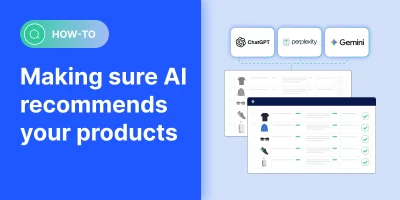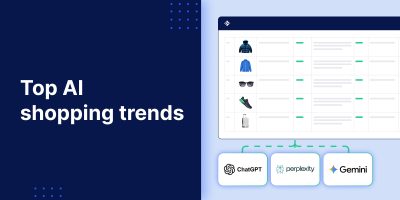The ecommerce industry is entering a new era—one defined not just by omnichannel selling, but by the rise of AI-powered answer engines (or AI answer engines for short) like ChatGPT, Perplexity, Gemini, and Copilot. Instead of typing short keywords into a search box, shoppers are increasingly asking natural, conversational questions and expecting precise, personalized answers.
To unpack what this shift means for retailers, Sharon Gee, SVP of Product AI at Commerce, sat down with Nigel Poole, Founder of Matter + Design, to talk about the Commerce brand launch, the future of agentic commerce, and how brands can prepare for this next frontier of discovery.
The Commerce brand is built for the AI era
The launch of the new Commerce brand — which brings together BigCommerce, Feedonomics, and Makeswift — is more than a new name. It’s a structural change designed to meet the demands of the AI era.
“Data is the new storefront. To help brands succeed in this AI era, we’re unifying technology and teams to power richer product data orchestration across every channel,” said Gee.
By integrating technology stacks and go-to-market teams, Commerce is positioning itself to deliver a connected ecosystem that empowers merchants with the data, tools, and insights needed to thrive in an AI-driven landscape.
The rise of AI answer engines
In traditional ecommerce, shoppers searched with short phrases: “size 10 linen dress.” Today, shopping behavior looks very different.
“Now I might say, ‘I’m going to a wedding in Italy. It’s going to be hot, and I want a pastel linen dress under $300 in a size 10. And people are already using AI platforms to search for products this way,” Gee said.
These long-form, contextual queries are where AI answer engines excel by delivering tailored product recommendations across channels. For retailers, the shift from shopper-to-merchant to agent-to-merchant interactions represents both a challenge and an opportunity. If your product data isn’t optimized, you risk being left out of the conversation.
What is agentic commerce?
As Poole pointed out, we’ve entered an era where AI agents act as shopping intermediaries. Gee described three stages of this new paradigm:
- Agentic discovery: AI agents surfacing product data on behalf of shoppers.
- Agentic checkout: Agents transacting securely with merchants.
- Agent-to-agent commerce: Future scenarios where shopper agents and merchant agents interact directly to negotiate and complete transactions.
“Agents are customers too,” Gee said. “They’re buying on behalf of shoppers, and brands need to treat them as such.”
Data as the new differentiator
Answer engines rely on more than traditional feeds — they need a combination of structured data and unstructured data to provide accurate, trusted answers.
Gee outlined three levels of data maturity:
- Structured feed data: product titles, descriptions, prices, and inventory sent to Google, Meta, and other platforms.
- Marketplace attributes: additional product details required by Amazon, eBay, and similar channels.
- Rich brand-owned data: contextual details like materials, use cases, reviews, and fit guides.
“SEO has always been about keywords, but AEO [answer engine optimization] is about providing good answers,” said Poole.
Implications for B2C and B2B brands
While consumer-facing brands are already seeing AI-driven traffic, Gee emphasized that B2B may benefit even more from agentic commerce.
“Agentic commerce is one of the biggest opportunities for B2B brands to leapfrog into the AI era,” she explained. In one demo, a buyer simply dragged a PDF purchase order into an AI agent, which instantly built a cart and completed checkout — a major reduction in friction for complex transactions.
For B2C brands, especially in categories like fashion and beauty, the opportunity lies in impulse purchases and highly personalized experiences.
How brands can prepare now
Although the shift may sound futuristic, Gee stressed that retailers can start today:
- Audit and enrich product data. Invest in both structured feeds and unstructured content like reviews, guides, and videos.
- Expand syndication. Don’t just send data to Google and Meta — start pushing it to new AI-driven platforms like ChatGPT and Perplexity.
- Invest in context. Rich product details and authentic user content help answer engines choose your brand over competitors.
- Test and learn. With no decades-long playbook for AEO, retailers must experiment, measure, and adapt.
“It doesn’t have to be scary. Brands can start by sending the data they already push to Google to new answer engines like Perplexity and ChatGPT, then optimize over time,” Gee said.
Feedonomics enriches product data for AI discovery
Conclusion
The rise of answer engines signals a fundamental shift in ecommerce — but also a tremendous opportunity. Brands that invest in better data, broader syndication, and agent-ready strategies will be best positioned to capture traffic, drive conversions, and build loyalty in the AI era.
As Gee put it: “If we can remove friction and decrease cost by integrating AI into these shopping experiences, we all just get a better version of shopping on the internet.”
To help build that better future of shopping, Feedonomics is helping retailers optimize product data and unlock growth across every channel.
Ready to prepare your brand for the AI era?

Mario is a senior content marketing manager based in Texas. He enjoys solving problems, learning about new ecommerce tech, and breaking down complex topics into useful tips for readers.



